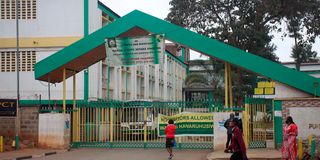
Pumwani Maternity Hospital in Nairobi.
It is important that Kenya has an honest discussion about having specialist hospitals for women and children, spread countrywide. These are currently small departments within public hospitals. Even then, they are just a footnote.
The only public hospital for children in Kenya is Pumwani, in Nairobi, which was built by the British colonial government decades ago. It is not enough to cater for residents of Eastlands, let alone Nairobi or the rest of Kenya.
Successive Kenyan regimes have gone gung-ho investing in brick and mortar that we rarely need. For instance, stadiums in every county were the most idiotic thing a country such as Kenya would plan for when it lacks even one fully functioning public hospital.
The death of renowned reggae DJ Njambi Koikai from endometriosis makes it even more poignant for women with severe to serious gynaecological and obstetrics problems to have access to specialist hospitals and consultants. Kenya does not have a seamless regime where expectant women can be followed up from early pregnancy to childbirth.
Pregnant women
Some of the complications suffered by pregnant women and those with gynaecological problems could be eradicated with early diagnosis and follow-up. Women who live in rural Kenya and furthest from 'civilisation' are even at greater risk due to the lack of specialist hospitals nearby. By the time a woman with pregnancy complications is flown to, say, Nairobi for specialised treatment, it is too late for her and her baby.
Kenya has one of the highest mother and child deaths due to complications during pregnancy and at birth. More than 6,000 mothers die in Kenya during childbirth. Some of the complications, such as haemorrhaging (post-partum bleeding of mothers), have been eradicated in the West by the use of uterotonic drugs such as oxytocin, carbetocin and ergometrine, to name a few. These are recommended by the World Health Organization (WHO).
I know I am being naïve to even suggest such drugs in a country that fails to stock basic painkillers for its patients and 'forgets' to procure children’s vaccines. But it is important to share such information so as to end the deaths of women during childbirth.
Public hospitals
Poor maternity services at public hospitals have forced women to rely on private facilities and, financially and ethically, is problematic. Some consultants in private hospitals have turned to butchers and hardly think beyond Caesarean section procedures, where women are made to undergo unnecessary surgery to deliver a baby, as C-section have become all about money. And it is not just maternity care that is wanting. Gynaecological problems such as endometriosis do not have a cure yet, according to the WHO.
One way to help sufferers, apart from strong painkillers, is laparoscopic surgery, where endometriosis tissues are lasered or removed. This is just to help to ‘control the symptoms’ of endometriosis, according to WHO. The global health body defines endometriosis as "a disease in which tissues similar to the lining of the uterus grow outside the uterus. It can cause severe pain in the pelvis and make it harder to get pregnant". The disease affects 10 per cent of the reproductive age women and girls.
Endometriosis is hard to diagnose, according to WHO. I would imagine it could be even harder in developing countries, such as Kenya, with poor healthcare systems.
The diagnostic process of endometriosis involves different pathways—from looking at a patient’s menstrual history to the use of ultrasound and other imaging procedures such as MRI. WHO also recommends the use of "surgical or laparoscopic visualisation to confirm the diagnosis".
Surgical machines
Most Kenyan women and girls cannot afford these overly expensive diagnostic processes. Public hospitals do not have a history of providing imaging and surgical machines and, if they do, they are at private centres and too expensive for most people.
Many surgical decisions in Kenyan hospitals tend to be made unilaterally by one doctor and who, in some cases, is not even qualified to offer a surgical procedure. That puts the lives of women and children at risk by offering surgical procedures that are hardly required for the sake of money.
A blueprint for surgical decisions need to be designed so that any procedure, however small, is decided by a group of specialists and qualified consultant surgeons. Many hospitals in the West use the MDT (multi-disciplinary team) approach, where surgical decisions are made in a consensus between qualified surgical consultants to minimise the risk of harm and cut death rates in hospitals.
The health of women and children, including maternal health, need more input from the government to save them from dying from preventable diseases and poor and unnecessary surgical procedures. There is a need, therefore, to consider building specialist hospitals in the counties to offer women and children healthcare under one roof.
More funding needs to be set aside to help women and children suffering from various diseases and complications and also follow-ups. The Sh10,000 maximum set aside by the Social Health Insurance Fund (Shif) is not enough to deal with the treatment of complex diseases of women and children. It is, in fact, an unkind offer!
Ms Guyo isa legal researcher, [email protected]. @kdiguyo










